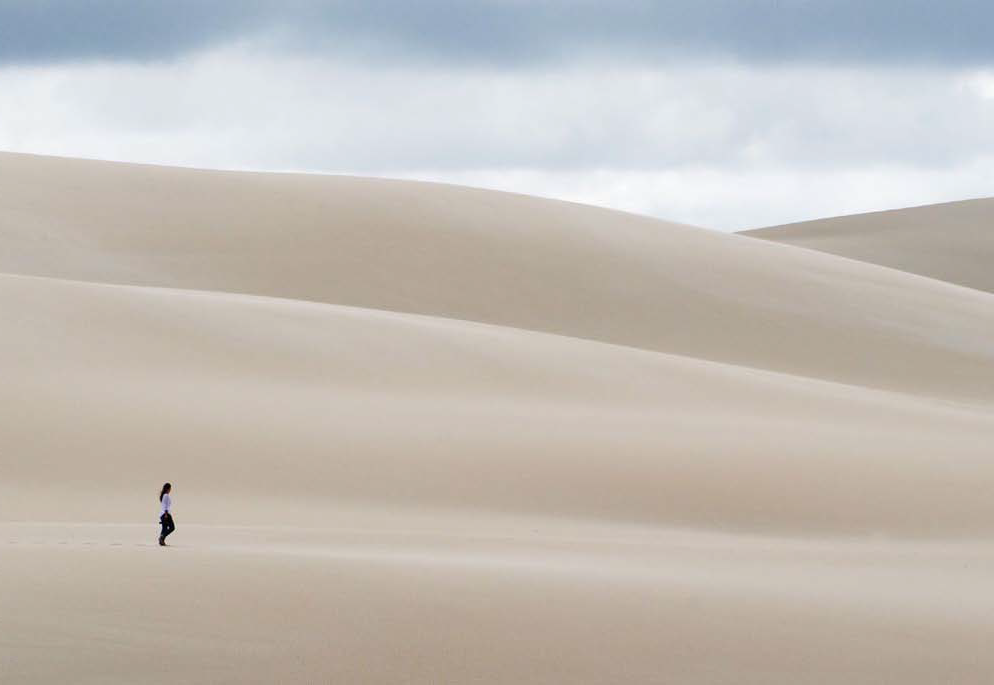
The stunning white dunes of Hamersley in the Fitzgerald River National Park, on the south coast of WA. Tourism WA
Desert and deserted are not mutually compatible terms. Sure, there’s a lot less of everything out in the middle of the Outback; but there is really a lot more than you might think.
The deserts are alive with reptiles, marsupials, birds and insects. And it takes little more than a sprinkle to turn a landscape that might seem predominantly red dirt into an explosion of greenery or blankets of colourful wildflowers. And of course there are the people – enjoying the rough but honest lifestyle far from the big cities. In this article we’ve highlighted a selection of these desert experiences.
Of course, deserts can be beautiful but dangerous places and proper precautions need to be taken when venturing into them. These include but are not limited to ensuring you have adequate supplies of fuel, food and water in case you get stranded; ensuring your vehicle is mechanically sound and roadworthy and that you are carrying appropriate spare parts – including a strong jack and, if possible, two spare wheels.
Carry a minimum of six litres water per person per day, plus a three-to four-day reserve supply of water and food. Calculate distances between refuelling points and remember frequent low gear and 4WD work uses more fuel, so it’s a good idea to double your estimated consumption.
Also take tools such as a long-handled spade, tyre levers and pressure gauge, air compressors, spanners, multigrips, screwdrivers, pliers, hammer, electrical tape, WD40, spare fan belt, radiator hoses, coolant, engine and transmission oil, spark plugs, fuses, spare fuel filter, fence wire and plastic tubing. Other recovery equipment includes maps, compass, GPS, jack and plate, wheel brace, tyre levers, tube mending kit, two ropes, leather gloves, winch and sling, tree protector, D shackles, snatch block and straps, jumper leads and booster cables. And of course a first aid kit and sun protection.
You should also take precautions by notifying a responsible person of your itinerary, intended route, stopovers and arrival times and dates. Then contact them, leaving a message, when you get to each notified stopover.
Of course, only take roads that are suitable for your type of vehicle and bear in mind dirt roads can turn into impassable mud very quickly with even a small amount of rain.

The big sky is one of the most startling things about the outback. Tourism Qld
Some seasons are not suitable for travelling into the desert regions because of the way rain affects the roads, or because the temperatures get too hot. Be sure to check what time of year is best to go to each location, and check the conditions of roads and weather forecasts before leaving major towns.
You should also carry a satellite phone, EPIRB and a UHF radio, as normal mobiles do not work in most outback areas away from the sealed highways.

There’s nothing quite like a campfire in the desert. Tourism Qld
Much driving in desert regions is 4WD only. Make sure to drive the 4WDs at reduced speeds on unsealed roads. Dust will limit your visibility, so take care when overtaking, especially road trains. Take frequent rest breaks and change drivers regularly. Obey all road closure signs.
Most importantly: if you break down, do not leave your vehicle.
Also bear in mind that temperatures vary dramatically – some times by more than 40 degrees in a day. So keep warm clothes for the evening.
It’s a good idea to travel with other vehicles to reduce the need for expensive outside help if you have an accident or breakdown. Get prior permission from landholders before crossing private or Aboriginal Lands.
The South Australian government has a useful guide to travelling in the desert which can be downloaded from www.environment.sa.gov.au/parks/Safety/desert-outback-wise.

The spectacular Lawn Hill Gorge. Tourism Qld
The Simpson and beyond
The Simpson Desert National Park is enormous, spanning more than one million hectares across three states: Queensland, South Australia and the Northern Territory.
Sand dunes dominate this landscape with the biggest stretching 200 kilometers and reaching up to 90 metres high. Arid but beautiful, spinifex swales are interspersed with red sandy dunes.
Due to extreme heat, the Simpson Desert is closed annually from December 1 to March 15. Temperatures hit between 40 and 50 degrees Celsius.
There are some nature-focussed festivals and events in the Simpson, including the tortuous Big Red Run – but bear in mind, this is definitely not for the faint-hearted or anyone who’s not super-fit. It’s Australia’s first and only 250 kilometre running race and competitors race 40 kilometres each day through skin-peeling heat, stomp through sinking sand and by night, camp out in freezing winter conditions. Evening entertainment and camp-fire cooking are put on by event organisers for competitors to enjoy. Multiple categories are available to choose from, ranging from the main 250-kilometre event to a smaller 42-kilometre desert dash.
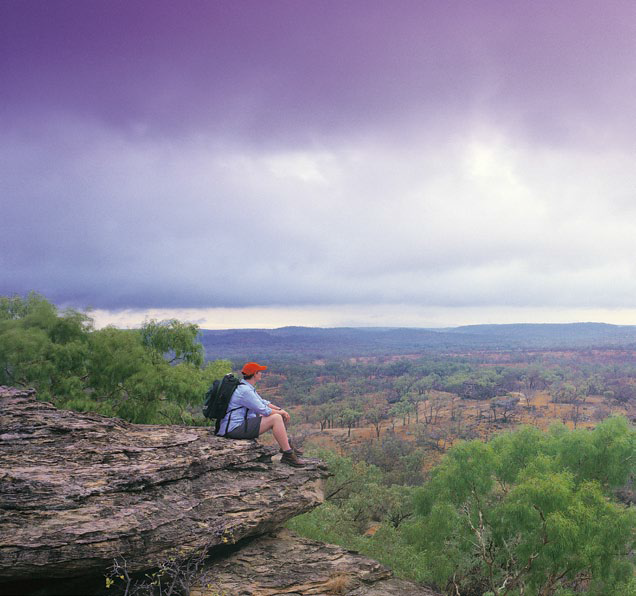
In the north, the deserts slowly transform into savannah. Tourism WA
If, like most of us, you’re after something at a more leisurely pace, you can try the Big Red Sunset Tour. You can experience the size and scale of the Simpson Desert while enjoying nibbles, bush tucker and a glass of your favourite tipple as your watch the sun set over the red plains. This tour runs daily from the Birdsville Caravan Park and takes guests through bronco branding yards, an Aboriginal tracker’s hut and Roseberth Station among other stops.

What’s that man doing in the middle of the desert? One of the Antony Gormley statues. Tourism WA
Out on the desert you can see strange things, and none stranger than the Min Min Light. Local folklore tells of a mysterious bright light which appears to the lonely traveller, often on dusk or at dawn, hovering on the horizon, glowing (almost watching, some say). Stop by to have a look at the mysterious ball of light that has intrigued locals and visitors for more than 100 years. Stories about these lights can also be found in Aboriginal myths and the light is said to sometimes follow or approach people and even be able to keep pace with a car.
In the Queensland town of Mitchell you can enjoy a dip in waters from the Great Artesian Basin. Dubbed the Great Artesian Spa, it is the town’s major tourist attraction and is heated naturally with waters from the Basin maintained at a comfortable 38 degrees. The thermal, mineralised waters are believed to have healing powers, prompting many travellers to soak up this Outback experience. Other towns with similar spas include Moree in NSW and Lightning Ridge, also in NSW.
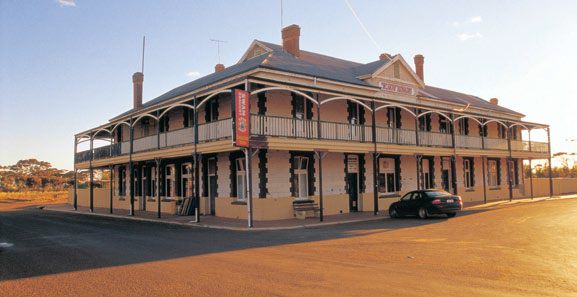
There’s still one popular way to quench a thirst in the outback. This classic pub is in Dumbleyung. Tourism WA
Another health option is to try the Mud Springs at Eulo, Queensland. You don’t need to spend hundreds of dollars on spa treatments when the outback has its own open-air mud treatment in the middle of Cunnamulla. Lovers of spa treatments and pamper packages will revel in the skin benefits of the zinc, magnesium, potassium, calcium and iron rich mud springs accessible nine kilometres west of Eulo. These mud springs were made from pressure in the Great Artesian Basin, which heats the water to a piping hot temperature. Unfortunately due to the sinking bores, this is one of the only mud springs left in the outback. At the end of your soak in the murky water – rinse off in a bush shower. A one hour long treatment will set you back $60. 
Western Australia’s wildflowers start to bloom in late July. Tourism WA
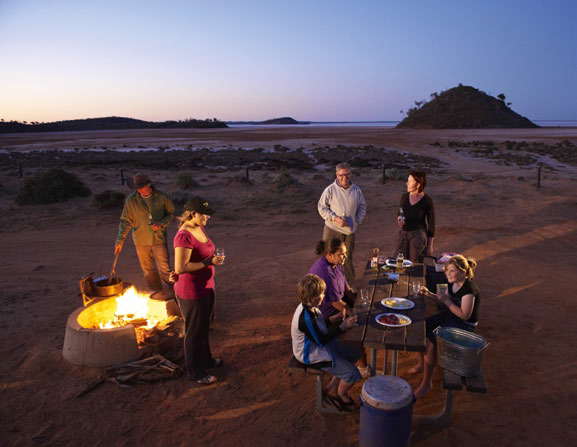
After viewing the statues, relax by Lake Ballard. Tourism WA
Out from Eulo you can experience the true outback style of the Outback Mail Run. Join the mailman as the postie delivers mail to 10 properties on his 400 kilometre run. This tour operates Monday and Thursdays. Dave Hammond, the local mailman, will share stories about the area and you can learn about the Duracks, Tullys and Costellos – the fearless families who put the Eulo area on the map by establishing sheep and cattle properties on the edge of the Simpson Desert.
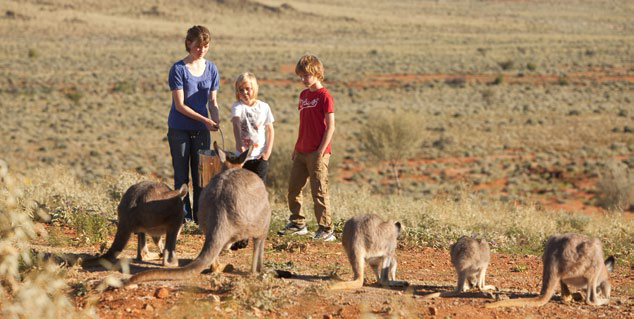
Wallabies and other wildlife including eagles and red kangaroos can be easily seen at the Living Desert Park. Tourism NSW
At Boodjamulla in the Lawn Hill National Park you can experience freshwater springs, sandstone cliffs and lush vegetation. The Park can be explored on any of the six walking circuits surrounding the spectacular Lawn Hill Gorge. A gallery of ancient Aboriginal rock art by the local indigenous Waanyi people can be found at the Wild Dog Dreaming Art Shelter by daring to take the bridge across the gorge. You can camp beside the creek and canoe up its reaches, but beware: on the lower gorge freshwater crocodiles are often found. There are quite long tracks around the park, so choose the one best for your ability.
Human form in the landscape
The big skies and long, wide open landscapes of Western Australia are the stuff of legend. And while the vast spaces seem uninhabited in parts, you might come across a man or a woman standing by themselves, naked to the sky and impervious to the seasons. Yes, it’s the iconic display of sculptures by world renowned artist Antony Gormley at one of Western Australia’s most unusual and remote cultural attractions near the town of Menzies: The Inside Australia project.

A real survivor and a desert inhabitant, caught on camera in the Living Desert park. Tourism NSW
Gormley wanted to find a human equivalent for this very geological place. The 51 works are positioned about 750 metres apart, installed on the western end of Lake Ballard. The horizon is flat for most of its 360 degrees. There is an ironstone mound 120 feet high that allows a vantage point to see more than 30 kilometres in any direction.
As people move across the work, they leave a tracery or drawing of connecting lines between the works across the sharp whiteness of the lake. This is a sign of the viewers’ participation in the work which changes, as does the sky, throughout each interval of the year. Gormley is currently looking at the Blue Mountains for his next Australian location.

Last petrol for many a mile. It pays to know where you can next fill up. Tourism Qld
The Big West is a great place for outback adventure, and there are even tours offering authentic Aboriginal experiences where you learn to forage for bush tucker, listen to dreamtime stories around the campfire and reach a deeper understanding of Australia’s indigenous culture. The Indigenous Tourism website has information about specific tours and locations (www.waitoc.com).
And of course, the West springs to life from late July with an explosion of colour. Western Australian wildflowers bloom in their billions after the winter rains and transform the beautifully rugged outback landscape into a brightly coloured wonderland. Here, you can picnic on a blanket of pink, yellow and white everlastings stretching as far as the eye can see, and marvel at over 12,000 wildflower species, including the striking wreath leschenaultia.
The season commences in late July, with Western Australian wildflowers colouring the north of the region, and finishes in the far south during December. Before you begin one of the many outback wildflower trails, call the local visitor centre for information about the variety and location of wildflowers in bloom.

And if you want to experience the desert from the comfort of the Gold Coast, try the Australian Outback Spectacular which celebrated its 2000th show in April.
Although Western Australian wildflowers can often be seen from the roadside, many interesting species can be found a short distance off the road and the local visitor centres will be happy to point you in the right direction.
To ensure you enjoy a safe and well planned journey, take a look at travel times and distances, road safety and important travel tips on the wildflowers website.
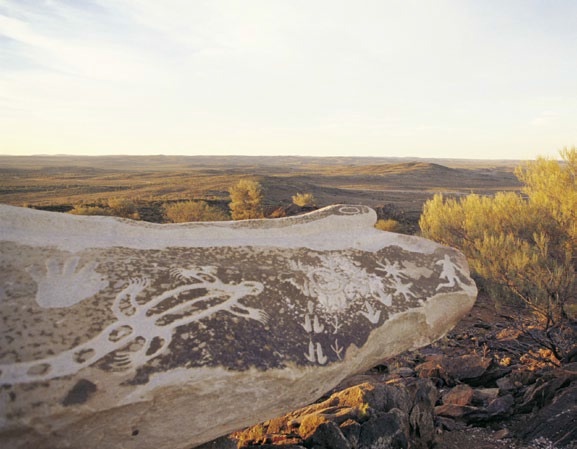
The Living Desert State Park is full of wildlife and also rock art. Tourism NSW
Flora and fauna sanctuary
The Living Desert State Park’s flora and fauna sanctuary is set amongst tranquil gullies and rocky outcrops. With a large biodiversity of native plants and animals, the sanctuary contains an animal viewing area, where you’re sure to see wallabies, red kangaroos and wedge tail eagles. You can also visit the an arboretum of endemic plants, or walk amongst numerous native species such as Sturt Pea, wattles and more.
The park is 12 kilometres from Broken Hill, nestled amongst the Barrier Ranges and is open 9am to 5pm (March-November) and 6am to 2pm (December-February).
The park has a number of paths that take up to three hours to complete, winding through the stunning sculpture symposium and the peaceful flora and fauna sanctuary. A cultural walk trail offers education on local Aboriginal heritage and the importance of preserving the environment. It is recommended to have plenty of water at hand during the warmer months as it can be thirsty work trekking around the area. It can also be extremely cold at during winter.
You can also take an organised tour of the park (08 8080 3560).
Category: Features
Written: Sat 01 Jun 2013
Printed: June, 2013
Published By:
For more information:
Tourism Queensland: www.queenslandholidays.com.au or 13 88 33
Simpson Desert: www.nprsr.qld.gov.au/parks/simpson-desert
Big Red Run: www.bigredrun.com.au
Big Red Sunset Tour: www.birdsvillecaravanpark.com
Min Min Light Encounter Centre: 07 4746 3386
Mitchell’s Great Artesian Spa: 07 4624 6923
Outback Mail Run: www.outbackmailrun.com
Mud Springs: 07 4655 4890
Travel NT: www.travelnt.com or 13 67 68
Tourism SA: www.southaustralia.com or 1300 764 227
Tourism Western Australia: www.westernaustralia.com or 1300 361 351
Antony Gormley: www.antonygormley.com
Indigenous Tourism in WA: www.waitoc.com
WA Wildflowerfs: www.wildflowerswa.com.au
WA Golden Outback: www.australiasgoldenoutback.com
Safe Desert Travel: www.environment.sa.gov.au/parks/Safety/desert-outback-wise
Travel NSW: www.visitnsw.com.au or 13 20 77
Living Desert NSW: www.stateparks.nsw.gov.au/living_desert
Outback Spectacular: www.outbackspectacular.com.au